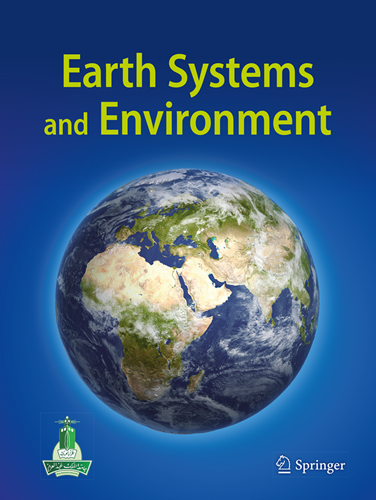检验使用单一短期历史流量期来评估尼罗河下游GERD填充水亏缺的准确性:技术说明
IF 5.3
Q1 ENVIRONMENTAL SCIENCES
引用次数: 0
摘要
日益增长的水和能源需求、水文气候波动、筑坝和使用权纠纷是全球跨境河流管理面临的主要挑战。特别令人感兴趣的是东尼罗河流域(ENRB),在上游水坝增加的情况下,应该采用哪种建模方法来解决河流沿岸国家在跨界水管理方面的差异,这受到了广泛的争论。一些研究模拟了不同水文条件下大埃塞俄比亚复兴大坝(GERD)蓄水过程中高阿斯旺大坝(HAD)下游蓄水量的变化。然而,他们的研究结果在GERD填充对HAD储存量的影响方面存在分歧,特别是当考虑到一个特定的、自然的、历史的10年期间来代表使用的平均流量条件,作为评估潜在下游影响的基准。我们对尼罗河流量历史记录的扩展分析表明,考虑一个单一的历史10年周期来模拟下游的水预算,正如Wheeler等人所做的那样(Nat comm 11:5222, 2020, https://doi.org/10.1038/s41467-020-19089-x),作为在平均流量条件下GERD填充不会在HAD产生赤字的有力证据,被广泛传达给决策者,这是不确定的,因为它强烈依赖于历史流入期的选择。由于河流年际流量变异性大。我们在Wheeler等人(Nat comm 11:5222, 2020, https://doi.org/10.1038/s41467-020-19089-x)的数据表中对20个平均/接近平均历史流量期的模拟结果表明,在相同的建模条件和填充策略下,其中60%产生的下游水亏在0.5 - 14.5 BCM之间。因此,考虑多个流量序列的模拟结果对于准确反映尼罗河年际流量高变异性对下游水亏评估的影响,从而解决跨界水管理预测中对GERD充注和运行影响的差异至关重要。本文章由计算机程序翻译,如有差异,请以英文原文为准。
Examining the Accuracy of Using a Single Short-Term Historical Flow Period to Assess the Nile’s Downstream Water Deficit from GERD Filling: A Technical Note
Abstract Increasing water and energy demands, hydroclimatic fluctuations, damming, and usage rights disputes present major challenges in managing transboundary rivers worldwide. Of particular interest is the Eastern Nile River Basin (ENRB), which is subject to broad debate over which modeling approach should be applied to resolve the disparities in transboundary water management among the river’s riparian nations, under increased upstream damming. Several studies have simulated the downstream High Aswan Dam (HAD) storage change during the Grand Ethiopian Renaissance Dam (GERD) filling under different hydrological conditions. However, their findings diverge regarding the impacts of GERD filling on HAD storage, especially when considering a specific, naturalized, historical 10-year period to represent the average flow condition used, as a benchmark for assessing potential downstream impacts. Our extended analysis of the Nile flow historical records demonstrates that considering a single historical 10-year period to simulate the downstream water budget, as performed in Wheeler et al. (Nat Commun 11:5222, 2020, https://doi.org/10.1038/s41467-020-19089-x), widely communicated to policymakers as a robust proof that GERD filling will not generate a deficit at HAD under average flow conditions, is inconclusive as it strongly depend on the selection of the historical inflow period, due to the river high interannual flow variability. Our simulation results of 20 average/near average historical flow periods in Wheeler et al. (Nat Commun 11:5222, 2020, https://doi.org/10.1038/s41467-020-19089-x)’s datasheet indicates that 60% of them generates a downstream water deficit ranging from 0.5 to 14.5 BCM under the same modeling conditions and filling policy. Therefore, considering the simulation results of multiple flow sequences is crucial for accurately reflecting the impact of the Nile’s high interannual flow variability on downstream water deficit assessments, thereby settling the disparities in transboundary water management forecasts for the impacts of GERD filling and operation.
求助全文
通过发布文献求助,成功后即可免费获取论文全文。
去求助
来源期刊

Earth Systems and Environment
Multiple-
CiteScore
15.50
自引率
5.60%
发文量
50
期刊介绍:
Earth Systems and Environment(ESEV) publishes peer-reviewed original and review articles on the entire range of Earth systems and environment in order to further our understanding of the natural workings and various processes and interactions that govern the Earth systems in response to complex environmental problems caused by natural and human-induced forcings.
The journal disseminates high-quality information on cutting-edge developments in the various research fields of Earth systems and environment based on new methods, theories, and applications. It has a multidisciplinary character, focusing on interrelated scientific topics combining diverse aspects of the Earth systems and environment including:
Climate and atmospheric sciences; Earth and environment related agricultural sciences; natural hazards and engineering; marine sciences; ecology; desertification; pollution; geo-environmental hazards; droughts and floods; hydrosphere, lithosphere and troposphere dynamics; waste management; numerical models of earth systems; geographical information systems; remote sensing; and environmental health, etc.
In order to meaningfully explore these topics, researchers in the environmental Earth science disciplines are invited to contribute their original research and review articles on significant scientific advances in the form of papers, technical notes, broad reports, case studies, reviews, brief communications and discussions.
More about the journal:
Published by Springer in partnership with King Abdulaziz University (KAU).
Indexed in Web of Science ESCI and Scopus (2021 Cite Score = 6.5).
Authors of the best papers receive an award and a remuneration from KAU each year.
Papers are screening for originality and similarities before handling them by topical editors.
The journal uses double-blind review.
The first round of peer review does not exceed 30-45 days.
Mostly two/three or even four revisions are required before final acceptance.
Committed to meeting standards of ethical behavior at all stages of the publication process.
The COPE code of conduct and Springer editorial policies are used as the basis for the publication process.
Earth Systems & Environment (ESEV) is committed to upholding the integrity of the scientific record. As a member of the Committee on Publication Ethics (COPE) the journal will follow the COPE guidelines on how to deal with potential acts of misconduct. Authors should refrain from misrepresenting research results which could damage the trust in the journal and ultimately the entire scientific endeavor. Maintaining integrity of the research and its presentation can be achieved by following the rules of good scientific practice as detailed here:
https://www.springer.com/us/editorial-policies
 求助内容:
求助内容: 应助结果提醒方式:
应助结果提醒方式:


